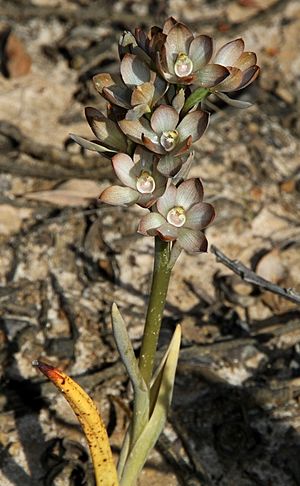Metallic sun orchid facts for kids
Quick facts for kids Metallic sun orchid |
|
|---|---|
 |
|
| Thelymitra epipactoides near Port Campbell | |
| Conservation status | |
| Scientific classification | |
| Genus: |
Thelymitra
|
| Species: |
epipactoides
|
The metallic sun orchid (Thelymitra epipactoides) is a special type of orchid that only grows in south-eastern Australia. It's known for its single, large, leathery leaf and its beautiful flowers. These flowers can be pink or reddish, and they have a unique shape above their pollen-producing parts.
Contents
What the Metallic Sun Orchid Looks Like
The metallic sun orchid is a plant that grows from a tuber (a bit like a potato). It's a perennial herb, meaning it lives for more than two years. It has one thick, dark green leaf that is about 15 to 25 cm (6 to 10 inches) long and 1.5 to 2 cm (0.6 to 0.8 inches) wide. The base of the leaf is often reddish.
The Flowers
This orchid can have between five and twenty flowers on a single stem. The stem usually grows to be about 25 to 50 cm (10 to 20 inches) tall. Each flower is quite large, about 3 to 4 cm (1.2 to 1.6 inches) wide.
The flowers come in many colours! They can be pink, greenish, greyish, or pale blue. Some are orange, reddish, or even a shiny bronze colour, often looking like they have a coppery glow. The outer parts of the flower, called sepals and petals, are about 1.5 to 2 cm (0.6 to 0.8 inches) long.
The central part of the flower, called the column, is usually a lighter colour than the petals. It has a special shape with different lobes (parts) on top of the anther (where pollen is made). The main lobe is reddish-brown with a yellow tip. On each side of this main lobe, there are two other yellow-tipped lobes that curve towards each other, sometimes even linking together. These side lobes have thick, white hairs that look like a toothbrush!
When it Flowers and How it Reproduces
The metallic sun orchid flowers from September to November. Its flowers are pollinated by insects. They usually open up only on warm, sunny days.
How it Got its Name
The metallic sun orchid was first officially described in 1866 by a scientist named Ferdinand von Mueller. He wrote about it in his book Fragmenta phytographiae Australiae.
The scientific name, Thelymitra epipactoides, has a special meaning. The word epipactoides comes from another orchid group called Epipactis. The ending -oides is a Latin suffix that means "likeness" or "similar to". So, epipactoides means "like an Epipactis orchid".
Where it Lives
The metallic sun orchid is found in southern Victoria and in parts of South Australia. You can find it growing in different places like grasslands, heathlands (areas with small shrubs), and forests.
Protecting the Metallic Sun Orchid
The metallic sun orchid is considered an "endangered" species. This means there are not many of them left, and they are at risk of disappearing. Both the Victorian Government and the Australian Government have laws to protect it.
The main things that threaten this orchid are:
- Inappropriate fire regimes: This means fires that happen too often, not often enough, or at the wrong time, which can harm the plants.
- Weed invasion: Weeds are plants that grow where they are not wanted and can take over the space and resources that the orchids need.
- Grazing by rabbits: Rabbits eat the plants, which can stop them from growing and reproducing.
Images for kids



